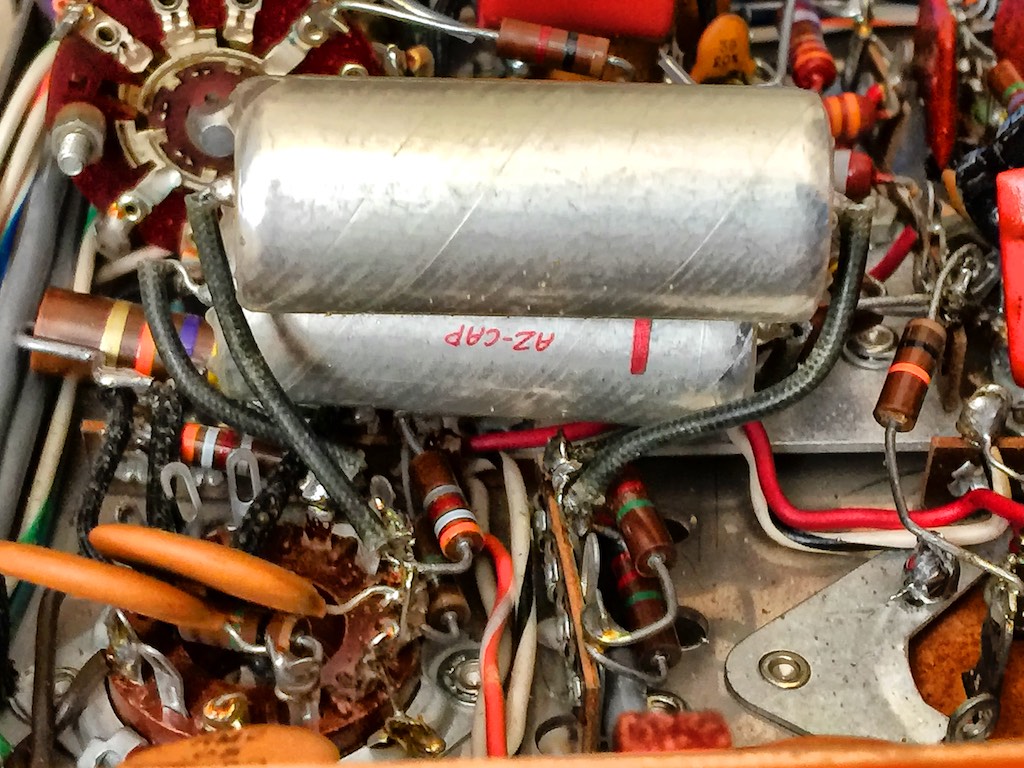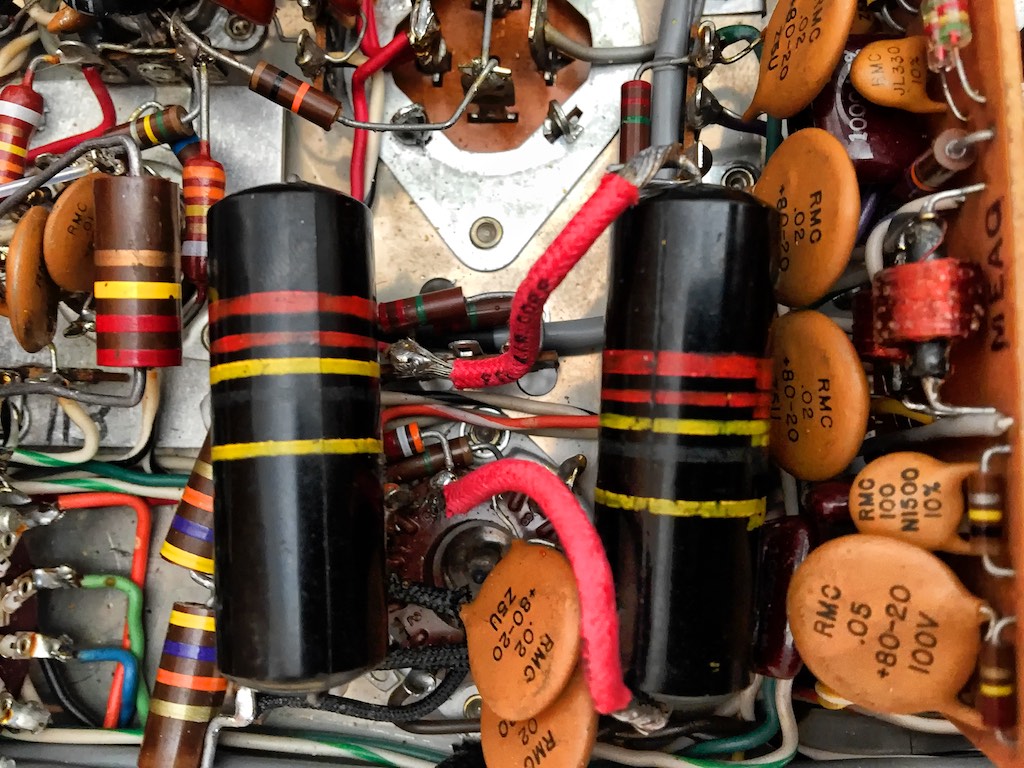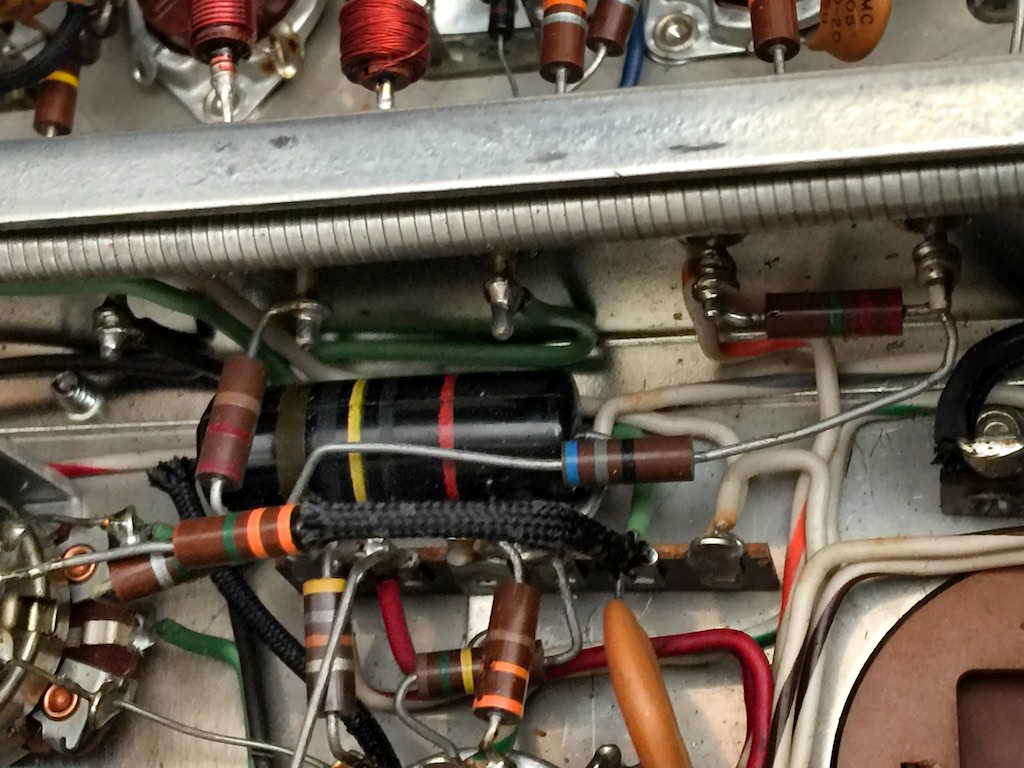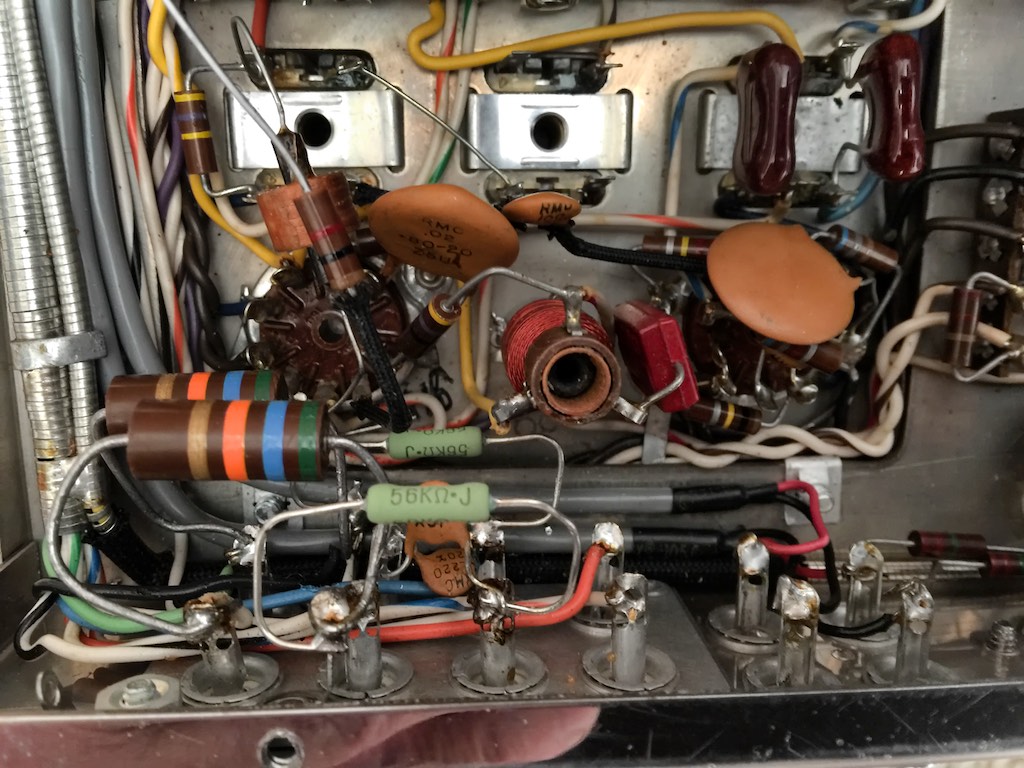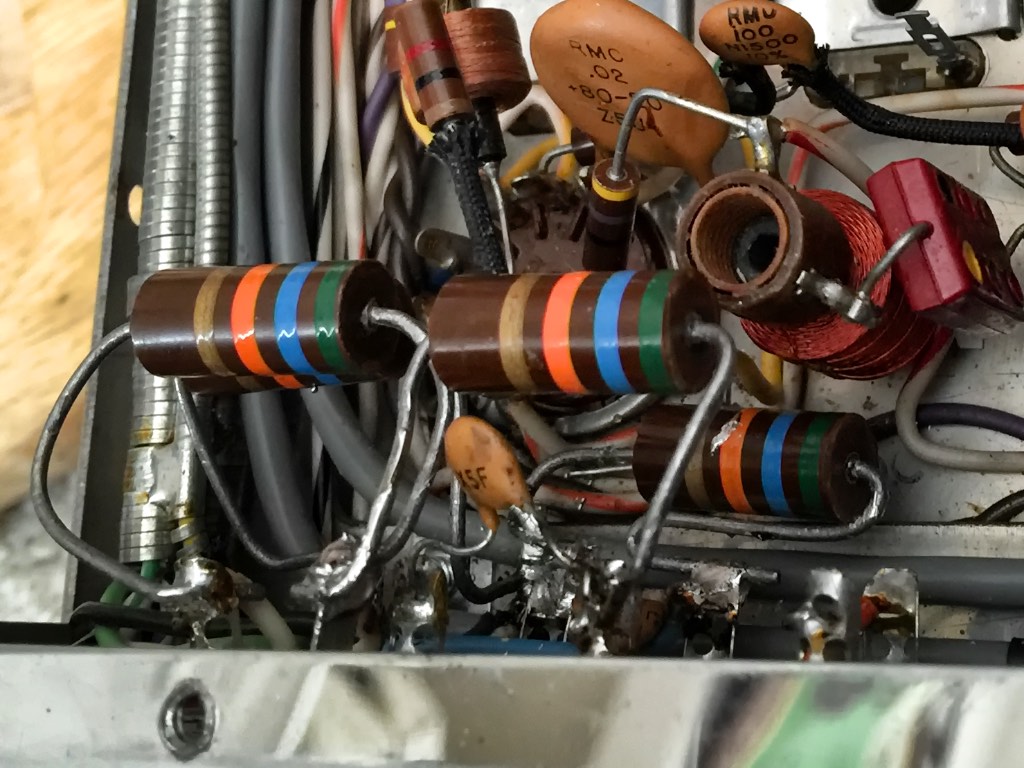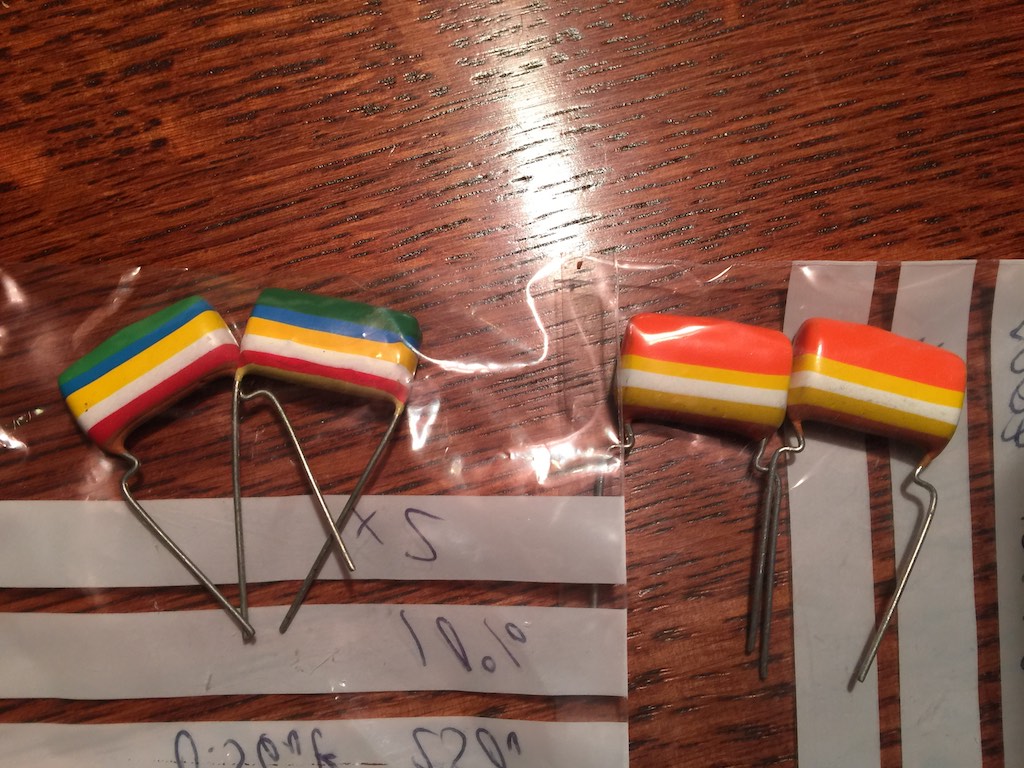After getting up this fine Saturday morning, while drinking a couple cups of my favorite coffee from Stumptown Coffee Roasters, I set about pulling off the bottom of my vintage vacuum tube McIntosh MX110Z tuner-preamplifier so I could do a little surgery on it.
I had two things I wanted to do while under the bonnet, the first being removing the pair of 0.22uF Red Cactus Arizona Capacitors I had doing duty at C93 & C95 and C94 & C96, and replacing them with a pair of vintage 0.22uF Sprague Bumblebee capacitors very kindly sent to me by Yves Beauvais at Vintage Vacuum Audio, that I mentioned in my last post (thank you, Yves!).

A quad of vintage Sprague Bumblebee capacitors, with an Arizona Capacitor for scale. Thank you, Yves!
I popped the bonnet off the MX110Z and set it aside, then took at look at the Red Cactus caps that Ron installed, admiring his beautiful work. I've found it to be a nice safety net to take a photo of anything I'm altering so I have a reference in case I get confused in the midst of my 'surgery'.
I warmed up my Hakko soldering iron and proceeded to remove the first Red Cactus. The Bumblebee I wanted to solder in didn't have long enough leads to reach the connection points, so I used some Western Electric WE16GA to bridge the gap. I would have preferred to use some vintage-style solid-core tin-plated copper pushback wire for this, but I didn't have any to use, so I'll have to order some for future use. I then repeated the procedure of removing the second Red Cactus and soldering in a vintage Bumblebee in its place. This time the Bumblebee's leads were long enough to reach the connections directly, so it was an easy install.
While I had the bonnet off of the MX110, I noticed that there were other original Bumblebees hiding in the shadows.
The second thing I wanted to do while I was under the bonnet of the MX110Z was to remove the Kiwame carbon film resistors that I had installed on phono input # 1 that I use to listen to mono records with.
The 56K Ohm Kiwame carbon film resistors actually sounded quite good, having better tone than any other resistor I tried except for the 2-watt vintage Allen Bradley carbon comp resistors.
Interestingly, while I didn't really like the tone of any of the metal-film resistors as well as the Allen Bradley's for PH2, which I use to listen to my stereo phono cartridges with, when I used metal-film resistors on PH1 for my mono phono cartridge they worked pretty well, very well, in fact.
My order of preference on mono was still for the tone of the Allen Bradley's, but the metal-film resistors - particularly the 56K Ohm Naked Ladies & Tepros - sounded pretty darn good and gave the Allen Bradley's a real run for their money, and even bettered them slightly in some ways.
Why there is such a disparity between stereo & mono I have no idea, but it does suggest that optimizing each phono input with the resistor you like the best is the way to go.
Ok, so out came the Kiwame carbon film resistors, and in went the Allen Bradley's.
I buttoned back up the MX110Z and installed it back into the system. After modifying circuits I always have a little trepidation when firing back up the equipment, keeping my fingers crossed that there will not not be a shower of sparks or plume of smoke coming up out of my MX110Z declaring my handiwork inept.
Fortunately I didn't screw anything up and my MX110Z powered up with no issues.
Well what do the vintage Sprague Bumblebee capacitors sound like when installed into C93 & C95 and C94 & C96?
Bloody good, mates, in fact I think they are the best sounding capacitors I've ever heard for those positions of the MX110Z.
A lot of guys get out their best sounding records first to test out the results of a performance modification, and that's cool, but I like to do the opposite, and get out the music I love that is the most challenging, due to the tricky nature of instruments used, or due to perhaps to it being a somewhat hot or borderline (ok, lousy) recording.
My take on it is that almost anything can make a really good recording sound pleasingly musical, but to make something a little dicier sound musically compelling takes some real artistry & magic in a component, and I want to be able to really enjoy all my music rather than just a few audiophile-style recordings. That's a mighty tall order to fill, but it is possible.
So first up for baseline impressions was a series of records with solo muted trumpet, massed brass, massed strings, female vocals, and ratty sounding recordings of music that I love.

A quad of vintage Sprague Bumblebee capacitors, with an Arizona Capacitor for scale. Thank you, Yves!
I really wondered if the well-loved vintage Sprague Bumblebees with lord knows how many hours on them, could sound as good as the impeccably made Arizona Capacitors, especially given that the Blue Cactus & Green Cactus Arizona capacitors are made of very similar materials to the vintage Bumblebees with their Mylar & aluminum foil construction.
In fact the Blue & Green Cacti capacitors do sound somewhat similar to the vintage Bumblebees, and may very well be as close as you can get to the vintage Bumblebee sonics & musicality in a modern capacitor.
So what exactly do the vintage Sprague Bumblebees sound like?
Well, consider these my first impressions, but like the guitarists say, they have a softer, smoother, richer, warmer, and sweeter presentation of the high-frequencies, with intensely hued tone color, and a very vibrant mid-range presentation that makes for an altogether more 'real' presentation, and one that seems to perform a little bit of magic that allows for an altogether more intense emotional connection to the music.
The Bumblebees smooth out that overt aggressiveness you hear sometimes in muted trumpets or massed brass that are not perfectly recorded, for example, and they can make less than perfect recordings in general sound more musically enjoyable.
The female vocals I have listened to so far have sounded gorgeous (Lucinda Williams, Rickie Lee Jones), and at least for Lucinda's World Without Tears album, it truly transformed it into rich musical experience, and that's saying something because that's a bit of a dicey recording.
From a sonics standpoint the Bumblebees are about as transparent & resolving as modern caps, and they throw an enormous soundspace, but they do it with a softer, sweeter, smoother presentation that I think is altogether more enjoyable.
Tonally, timbre is more realistically textured, more natural sounding, richer, and tone color is more deeply hued and obvious.
From a motional standpoint, tempos, melodies, beat, rhythms, and dynamics are just about perfectly portrayed, which I think is another reason they make music so compelling.
I also like that you can play music at live-like volume levels with the Bumblebees and it is very easy on the ears, and you don't feel a need to turn the volume down for the music to sound pleasing.
I'll keep you informed on how my first impressions hold up over time with the Bumblebees (I want to hear them through my Westminsters too), and I still have the vintage Mullard Tropical Fish capacitors to give a listen to that I want to tell you about, as well as some new production capacitors I ordered to try, whose identity shall remain a secret for the moment.
So anyways, at this moment in time the vintage Sprague Bumblebees are at the top of my list for capacitors in the C93 & C95 and C94 & C96 positions for my MX110Z.
Note: There can be significant risk to you and your equipment in using vintage capacitors like these half-a-century old Sprague Bumblebee capacitors that are not up to snuff.
To be on the safe side you should test them to make sure their capacitance & ESR have not drifted up, and also you should test the Bumblebees for DC leakage current as demonstrated in this video by ElPaso TubeAmps out on YouTube:
As always, thanks for stopping by, and may the tone be with you!





